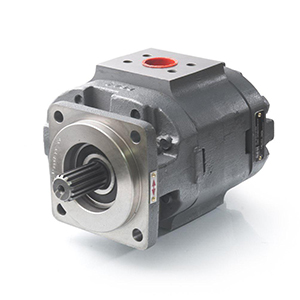Hydraulic Gear Hydromotor
Hydraulic gear motors (also known as hydraulic gear hydromotors) are a type of hydraulic motor that converts hydraulic pressure into mechanical motion. Specifically, they use gears to transfer fluid power into rotary motion, making them suitable for applications that require a high torque output at relatively low speeds. These motors are commonly used in industries like construction, agriculture, material handling, and manufacturing, where fluid power is needed to drive various machinery.
Types of Hydraulic Gear Motors
- External Gear Motors:
- These consist of two gears that mesh together: an input gear and an output gear.
- Hydraulic fluid enters between the meshing gears, causing them to rotate and generate torque.
- The input gear is driven by hydraulic pressure, and the output gear turns the motor shaft.
- They are known for their durability and simplicity, making them cost-effective and easy to maintain.
- Internal Gear Motors:
- In these motors, one gear is inside the other.
- The inner gear (the drive gear) is powered by hydraulic fluid and meshes with the outer gear (the driven gear).
- The space between the teeth of the gears fills with hydraulic fluid, and as the fluid moves, it causes the gears to rotate and produce torque.
- Internal gear motors generally offer smoother operation and lower noise levels than external gear motors.
How Hydraulic Gear Motors Work
Hydraulic gear motors operate on the principle of positive displacement. This means the same amount of fluid enters the motor and is displaced as the motor rotates, creating a constant torque at a given speed. The basic steps in operation are:
- Fluid Entry: Hydraulic fluid is directed into the motor through an inlet port, applying pressure to the gears.
- Gear Movement: The gears, driven by hydraulic pressure, rotate and move the fluid between them. As the gears turn, they create a suction effect that draws more fluid into the motor.
- Output Shaft Rotation: The rotation of the gears turns the output shaft, generating mechanical power that can be used to drive other machinery or components.
- Fluid Exit: After passing through the motor, the hydraulic fluid exits through an outlet port, often at lower pressure, to return to the system.
Key Characteristics of Hydraulic Gear Motors
- Compact Design: These motors are often smaller and more compact than other types of hydraulic motors (such as piston motors), making them ideal for applications where space is limited.
- High Torque: Hydraulic gear motors can produce a large amount of torque at low speeds, making them suitable for heavy-duty applications like lifting, pushing, or driving machinery.
- Reliability: The simple design and robust construction of hydraulic gear motors contribute to their long lifespan, even in harsh conditions.
- Cost-Effective: They are generally less expensive compared to other hydraulic motors (such as axial piston motors), making them a popular choice in many industries.
- Efficiency: Gear motors are relatively efficient, though they may not be as efficient as some other types of hydraulic motors, such as piston motors. However, their efficiency is still adequate for many applications, especially in low- to medium-duty tasks.
Applications of Hydraulic Gear Motors
Hydraulic gear motors are used in a wide range of applications, such as:
- Construction Equipment: Used in machinery like excavators, loaders, and bulldozers for moving parts, such as lifting arms or tracks.
- Agricultural Equipment: In tractors, harvesters, and sprayers, where precise control of movements is needed.
- Material Handling: In conveyor systems, hoists, and winches to provide the necessary torque and power for lifting or moving heavy materials.
- Automated Systems: In robotics and automated machinery that require compact and efficient power for various movements.
- Mobile Applications: Such as in hydraulic steering or lift gates for trucks, where power needs to be transmitted to drive a rotating system.
Advantages
- High Torque at Low Speeds: Hydraulic gear motors are ideal for applications that require substantial torque at relatively low rotational speeds.
- Durability: With fewer moving parts and a simpler design, they tend to have fewer points of failure and can handle rough operating conditions.
- Versatility: These motors can be used in a variety of settings, from high-powered industrial equipment to lighter-duty applications.
- Ease of Maintenance: Their simple design makes them easier to maintain and repair compared to more complex hydraulic motors.
Limitations
- Efficiency: While efficient, hydraulic gear motors are not as high in efficiency as other types, such as axial piston motors.
- Noise: Gear motors can generate more noise than other hydraulic motors, especially when running at higher speeds or under heavy load conditions.
- Limited Speed Range: While they provide excellent torque at low speeds, their performance at very high speeds can be less than ideal.
Conclusion
Hydraulic gear motors are a crucial component in various industries that rely on fluid power systems. Their robust design, efficiency, and high torque output at low speeds make them well-suited for applications that involve heavy lifting, material handling, or moving machinery components. While they may not have the highest efficiency or speed range compared to other types of hydraulic motors, they remain a reliable, cost-effective choice for many hydraulic systems.




